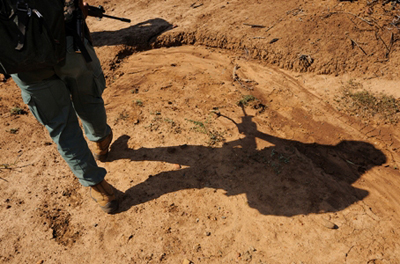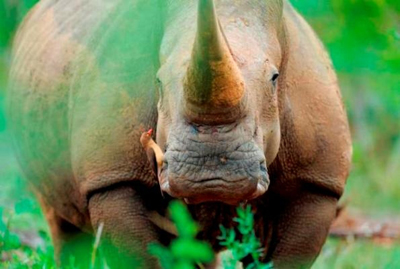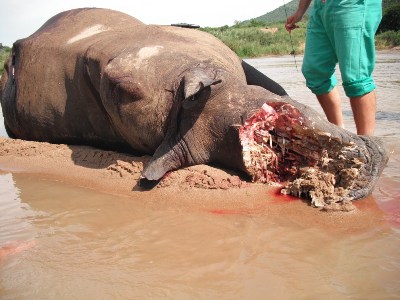
This is the first piece in a three-part series.
Somewhere in Eastern Cape, South Africa, one fateful morning, wildlife veterinarian Dr. William Fowlds received a call from Kariega Game Reserve. One of their rhinos had been poached. Fowlds recalls, "I expressed my heartfelt remorse and said I would be there later in the morning." There was a silent pause before the sledgehammer: "William, he is still alive!"
Dr. Fowlds did not hesitate. Thirty minutes later he found himself confronted with an animal, hardly recognizable as a rhino. His profile was completely changed by the absence of those iconic horns. The skull and soft tissue trauma extended down into the remnants of his face. Initially he stood on three legs with his mouth on the ground. Then he lifted his head up, revealing pieces of loose flesh that hung semi-detached from his deformed and bloodied face. Dr. Fowlds' vet report goes on.
Not all poached rhinos are tortured in this way. Many of them simply get shot with AK-47s. But many actually get immobilized with veterinary drugs before having their horns and underlying bones hacked off. In many cases, though, the amount of used drugs does not kill the rhino. If they don't bleed to death, they wake up under circumstances we don't want to imagine. Why does all this happen, at a rate that threatens the species with extinction -- once again? Because the rhinoceros' horn, despite containing nothing more interesting than plain keratin, similar to our finger nails, is worth more than gold, or even cocaine. Today you can buy a rhino horn on auction for about $35,800. Tomorrow you can sell the horn for about $179,200. In market language it translates into a rhino having a higher value dead than alive.
And indeed, the market is the crux of the matter. After a skyrocketing increase in illegally killed rhinos in South Africa over the last four years, the record was reached in 2011, with 448 animals falling victim poachers. Many of them were caught in the presumably protected Kruger National Park. In Vietnam, where the black market is booming, rhinos themselves run no risk, because there are none left. The last Javan rhinoceros in Vietnam was poached and killed April 2010. Why? Because in traditional Asian medicine the powdered horn is in demand for illnesses like malaria, epilepsy, poisoning, and abscesses. Ancient Chinese medicine texts recommended the horn for curing fever and arthritis. A few years ago in Vietnam, rumors started to circulate that some political VIP had been cured of cancer by using rhino-horn powder. Traditional Asian medicine had never suggested rhino horns as a cure for cancer, but now wealthy customers started to queue up.
Despite a 1993 ban on international trade in rhino horns by the Convention on International Trade in Endangered Species of Wild Flora and Fauna (CITES), rhinos more or less disappeared from all over Africa, except South Africa, Namibia, and Botswana. Now, it seems, the rhino is in for its final battle in these remaining countries. What we are up against? Exploiting of legal hunting as a way of laundering money; corrupt, complicit officials; unlicensed ivory-processing factories, rhino "farms" posing as safari parks; etc. Even Vietnamese government officials have participated in the illicit and lucrative trade. The rhino horn trade has developed into fully fledged, worldwide crime syndicates, and animals are not the only casualties.
This is the first piece in a three-part series.
PHOTOS (WARNING: GRAPHIC):

After the rhino
(Credit: Staffan Widstrand)

Face to face
(Credit: Staffan Widstrand)

Slaughtered
(Credit: Wildlands Conservation Trust)